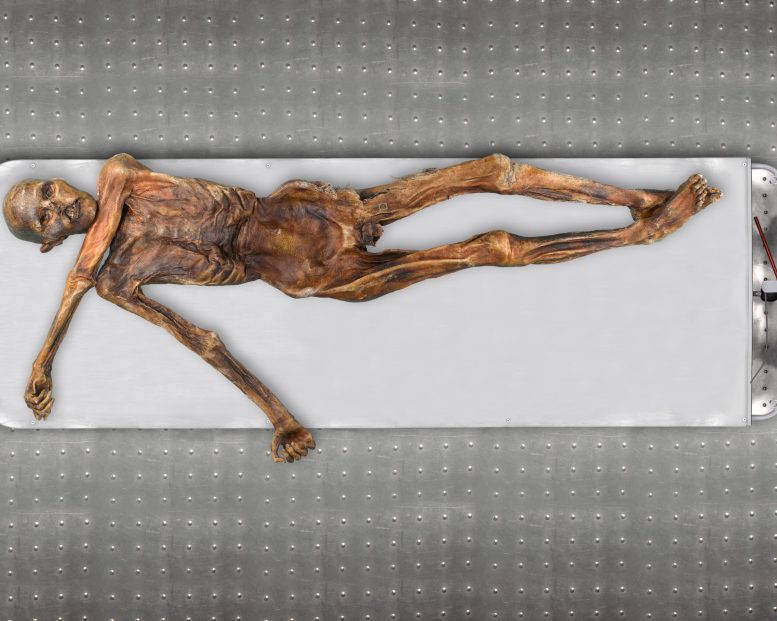
The Tyrolean Iceman is known as one of the oldest human glacier mummies. Credit: South Tyrol Museum of Archaeology/Eurac/Marco Samadelli-Gregor Staschitz
The latest research on the Neolithic Tyrolean Iceman, Ötzi, reveals surprising information about his appearance and ancestry. Contrary to previous beliefs, Ötzi had dark skin, dark eyes, and male pattern baldness. The high-quality genome analysis also shows that he had a significant early Anatolian farmer ancestry, suggesting he was part of an isolated Alpine population. These findings underline the importance of ongoing research, given the biases and limitations of earlier studies.
The Neolithic Tyrolean Iceman, popularly known as “Ötzi,” has been the subject of numerous studies over the years. However, the latest research, in which researchers have generated a high-coverage genome to learn more about his genetic history, presents unexpected findings. Published in the journal Cell Genomics on August 16, the research highlights that Ötzi had dark skin, dark eyes, and a balding head.
“The genome analysis revealed phenotypic traits such as high skin pigmentation, dark eye color, and male pattern baldness that are in stark contrast to the previous reconstructions that show a light-skinned, light-eyed, and quite hairy male,” said Johannes Krause from the Max Planck Institute for Evolutionary Anthropology, Germany. “The mummy itself, however, is dark and has no hair.”
The findings suggest that the Iceman in life looked more like the mummy does today, he notes. The more complete and higher-quality genome analysis also shows that the Iceman had unusually high early Anatolian farmer ancestry, higher than any other known contemporaneous population in Europe from the 4th millennium BCE. The discovery suggests that Ötzi belonged to a rather isolated Alpine population with limited gene flow from hunter-gatherer groups.
Preservation and Previous Studies
The Tyrolean Iceman is one of the best-preserved ice mummies and the oldest by far. As such, researchers have conducted many studies to learn about who he was, including studies of the Iceman’s genomic and ancestral composition. An earlier study from 2012 generated a lower-coverage genome that offered novel insights, despite considerable contamination from present-day human DNA.
The earlier research suggested a close genetic affinity between Ötzi and present-day Sardinians. But the researchers now say those conclusions were reached before more human genomes had become available. In the new study, the researchers, including Krause and Albert Zink of Eurac Research – Institute for Mummy Studies in Bolzano, Italy, sequenced Ötzi’s genome again using more recent sequencing technologies to produce a higher-quality genome. What surprised them the most was how the new data changes the picture of what Ötzi looked like.
“The most surprising results were the presence of male-pattern-baldness-related alleles supporting the absence of hair observed on the actual mummy and the rather dark skin pigmentation that is also supported by the mummy,” Zink says.
“It is remarkable how the reconstruction is biased by our own preconception of a stone age human from Europe,” Krause added.
Ancestry and Migration
Krause was also taken aback by Ötzi’s strong Anatolian lineage, revealing that he carried over 92% early Anatolian farmer ancestry. This discovery underscores the incredible migratory history of Europeans. The results imply that the Alps acted as a genetic divide. Hence, Ötzi’s community had limited genetic exchanges with populations located north and west of the Alps.
However, Krause cautions that it remains uncertain if Ötzi truly exemplifies the average individual of his time and place. To ascertain this, future comprehensive studies must analyze additional individuals from Ötzi’s era and region.
For more on this research, see Advanced Genetic Analysis of “Ötzi” Reveals Surprising Ancestral Roots and Appearance.
Reference: “High-coverage genome of the Tyrolean Iceman reveals unusually high Anatolian farmer ancestry” by Ke Wang, Kay Prüfer, Ben Krause-Kyora, Ainash Childebayeva, Verena J. Schuenemann, Valentina Coia, Frank Maixner, Albert Zink, Stephan Schiffels and Johannes Krause, 16 August 2023, Cell Genomics.
DOI: 10.1016/j.xgen.2023.100377
This work was supported by the University of Zurich.

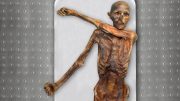
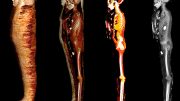

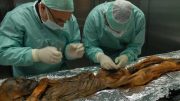

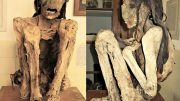
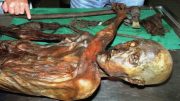
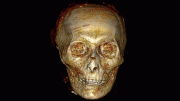
Be the first to comment on "Iceman’s Genome Reanalyzed: Ötzi Had Dark Skin, Dark Eyes, and a Balding Head"